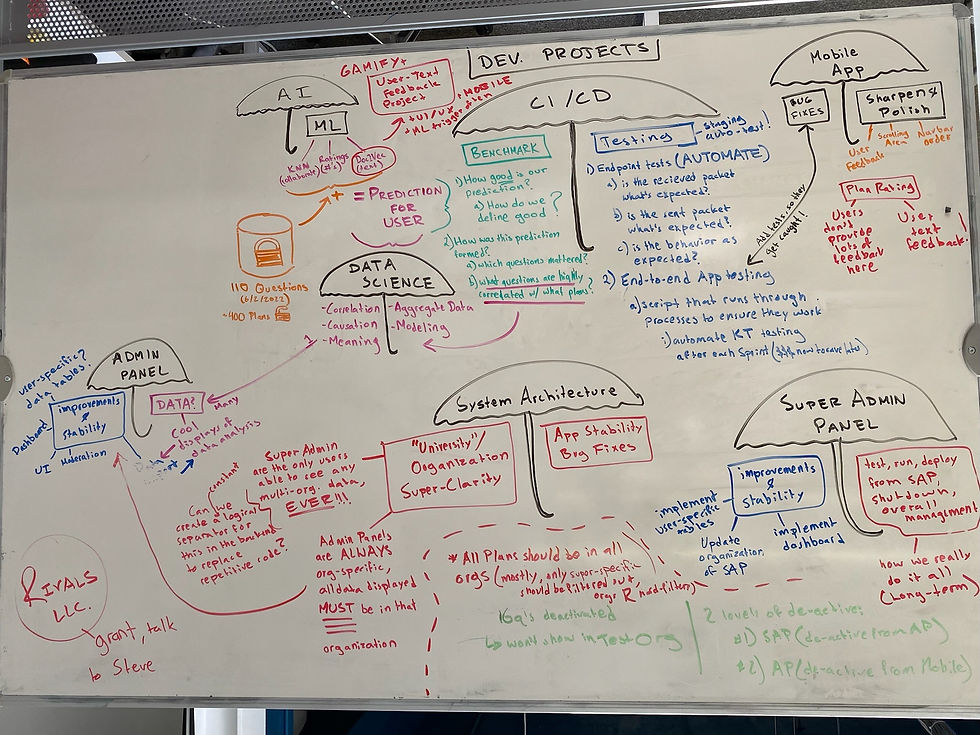TREES.app
- Jonny White
- Apr 1, 2023
- 3 min read
Updated: Dec 11, 2023
The question: Could we use data get the right advice to the right person at the right time?
The result: 4 years of research and development. Funding from 4 gov agencies in two countries. Trials then sales to universities and governments. A stable EdTech company.

How it started: I drafted a book of advice on how to use our devices and the internet rather than be used by them. As I shared the book with students, colleagues, and friends, they would inevitably say something like "Oh, I loved page 131" or "Oh, the diagram on pages 53-54 was perfect for me." But everyone liked a different page. Naturally, I would ask, "What about the rest?" My readers would equivocate politely. Under further scrutiny, they couldn't remember much of the rest. I realized that a book is a terrible delivery mechanism for advice.
A better delivery mechanism for advice—I hypothesized—would use the best and quickest possible survey questions to learn about the user, then give the user the right piece of advice for them, then track how well the advice was received in order to improve recommendations for them and for others over time. I started mentioning this idea to friends and colleagues. One ambitious friend me his postdoc and got us grant funding. Another invested in the ideas as a business and encouraged me to quit my job. Off we went with Design Thinking—cardboard prototypes, interviews, digging into existing research, think-aloud studies, keynote prototypes, and learning all about ML (machine learning) and AI (artificial intelligence).
Who will buy it? We started researching and designing UX/UI frameworks and recommendation engine models, consulting with professors in Canada and the California. We realized we'd have to build a custom ML. We wrote up the idea and got a little funding to do so from Mitacs Canada, the Social Sciences and Humanities Research Council of Canada, and a little more from Berkeley/NSF to find a buyer. We researched and built with professors and graduate students at my alma matter, Saint Mary's University. We were trained under the NSF regional and national Innovation Corps programs to run customer development research. After 137 interviews across hospitality, fitness, parenting, healthcare, postsecondary education, insurance, and corporate HR, we found that the most eager buyers were college and university student success leads. They wanted to get the right resource to the right student at the right time. We discovered that their current methods (sprawling outdated websites, emails, and pamphlets) were not decreasing in effectiveness over time.

Problem/Opportunity 1: But would students take a questionnaire that's long enough to be psychometrically valid? Would it provide the necessary data? With a lot of lean prototyping I invented a new mechanism—a "slider" (now provisionally patented) that starts when touched, moves with the thumb, and completes and advances to the next question when released. This means each question is answered in one gesture, improving upon the UX/UI of current survey methods. Also, and on top of us getting data on where the slider lands, we also capture data on hesitation, waffling, gesture force, and speed—all very nutritious for a hungry machine learning algorithm.
Problem/Opportunity 2: But would students read the plans? The evidence on this question was a bit inconclusive. Certainly they did read them when shown them in front of researchers, and certainly they did when paid to partake or sent a plan that was just for them. But in (fake) organic settings like (ostensibly) using the app while waiting for the research to begin, they spend much less time on the text—as you'd expect perhaps. And I knew from the literature and from previous eye-tracking studies I've run just how little anyone engages with blocks of text in digital media (So congratulations if you're reading these words—you're a rare one!). We tried other forms of content and—as expected—pictures performed well, links performed well, calendar events performed well, maps performed well, and videos performed very well, especially when they were local and relevant to the student. Thus, we adopted short form video as the "cover" for plans in our Swipe Mode.
What I'm saying is, would a student prefer this?

...or this?
And then? We began attending conferences, talking to student success experts, sharing our findings and data, researching and working with admins to create our admin panels, and generally having the manic ups and downs that accompany startup life. The app will be in five universities this fall, has won two government contracts, a couple rounds of funding, and may even expand to other verticals as a the data set grows (for testing, HRTech, sales teams, veterans, mental health, addiction recovery are all on the list).










